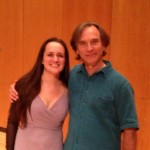Ovejita | Song by Frank A. Wallace
by Frank A. Wallace
for low or medium voice and 10-string guitar
SUGGESTED DONATION: $4.00
Lyrics: poetry in Spanish from the play La Casa de Bernarda Alba by Federico García Lorca
Commissioned by: Emerson College Drama Department for their production of the play The House of Bernarda Alba, Sunil Swaroop, director
Duration: 3:00; 3 pages
Written in: March, 2010
Language: Spanish
Difficulty level: moderate, some fast passages and dramatic leaps for singer
Instrumentation: mezzo-soprano and 7 (or up to 10) string guitar
World premiere: by Duo LiveOak, St. Joseph Guitar Festival, May 22, 2010
All Gyre compositions are ASCAP
Copyright ©2010 Frank A. Wallace
Cover photography and design by Nancy Knowles
All rights reserved.
Tweet
I wrote Ovejita and Paca la Roseta to be performed with the entire play The House of Bernarda Alba at Emerson College in April of 2010. The music was commissioned by the College and the play’s director and adapter Sunil Swaroop and his assistant Zac Baker-Salmon. It was my first music for a staged production. The full version of both pieces were not debuted until Duo LiveOak’s performance at the 2010 St. Joseph Guitar Festival in St. Joseph, Missouri.
Ovejita, “The little lamb,” is the only actual song from the play, sung by grandmother Maria Josefa who is considered senile, but truly she is the wise fool in Lorca’s conception. She describes a haven on the beach where she and the lamb she carries, claiming to have given it birth, will find peace. Paca la Roseta is an incidental character, a lascivious young woman who is carried off on horseback, willing and bare-breasted, by the virile young men of the town, that being a stark contrast to the cloistered lives of Bernarda’s five adult daughters. This is the first solo I have written for ten-string guitar.
Ovejita
Federico García Lorca (1898-1936)
from La Casa de Bernarda Alba
translation: Nancy Knowles
Ovejita, niño mío,
vámonos a l’orilla del mar.
La hormiguita estará en su puerta,
yo te dare la teta y el pan.
Bernarda,
Cara de leoparda.
Magdalena,
Cara de hiena.
¡Ovejita!
Meee, meee.
Vamos a los ramosdel portal de Belén.
Ni tú ni yo queremos dormir.
La puerta sola se abrirá
y en la playa nos meteremos
en una choza de coral.
Bernarda,
Cara de leoparda.
Magdalena,
Cara de hiena.
¡Ovejita!
Meee, meee.
Vamos a los ramos del portal de Belén!
Little lamb, my child,
Let’s go down to the edge of the sea.
The little ant will be in her doorway,
I will give you my breast and bread.
Bernarda,
Leopard-face.
Magdalena,
Hyena-face.
Little lamb!
Baa, baa.
Let’s go to the palms at Bethlehem’s gate.
Neither you nor I want to sleep.
The door will open all by itself
And we will curl up on the beach
In a hut of coral.
Bernarda,
Leopard-face.
Magdalena,
Hyena-face.
Little lamb!
Baa, baa.
Let’s go to the palms at Bethlehem’s gate!
“He understands that the guitar is itself one or more dramatic characters, sometimes adding characterization to the vocalist, at other times confronting her with fresh ideas to reflect upon. Even when there is no human voice, as in the purely guitar composition “Paca la Rosetta”…the guitar seems to sing. The piece is rhythmic and driven, yet also lyrical and reflective.”
“Ovejita, with words from the post Federico Garcia Lorca, is an evocation of madness. Wallace’s music somehow suggests a waterborne journey, oars propelling the character forward, an old woman overcome by insanity as she sings to a lamb she imagines to be her child. Knowles singing is brilliant–”




